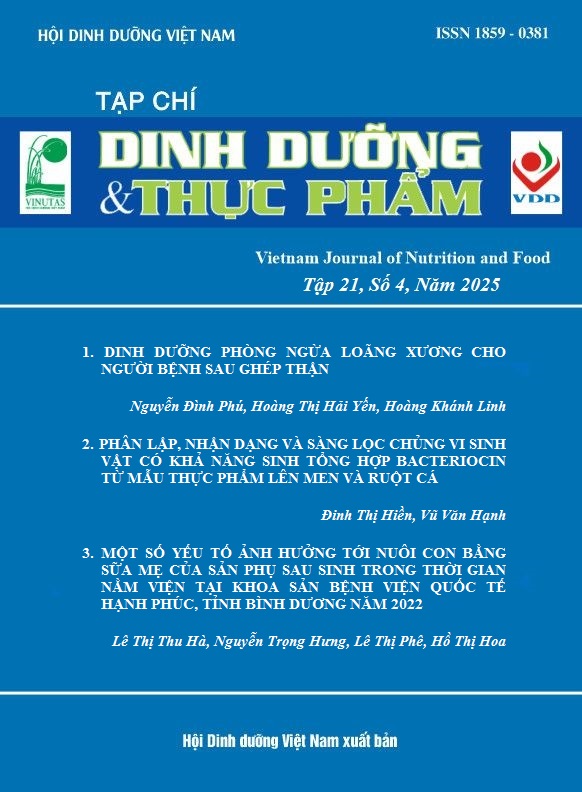ASSOCIATION BETWEEN NUTRITIONAL STATUS AND PHYSICAL ACTIVITY AMONG ADOLESCENT STUDENTS IN HO CHI MINH CITY, 2025
Main Article Content
Abstract
Aims: To describe the current status of physical activity and analyze the relationship between nutritional status and physical activity in adolescent students in Ho Chi Minh City in 2025.
Methods: A cross-sectional study was conducted on 903 students aged 12-18 years in Ho Chi Minh City, from January to February 2025. The study collected anthropometric indices of weight and height, physical activity.
Results: Over 75% of the students met the recommendations of World Health Organization for physical activity (50.28% in males and 27.36% in females). Students in suburban areas tended to engage in vigorous-intensity physical activity (46.75%), while those in urban areas were more likely to participate in moderate-intensity activity (39.76%). Overall, vigorous-intensity activity accounted for the highest proportion across the sample (41.20%). The students met physical activity recommendation were more likely to overweight and obesity than those did not (OR = 1.49; 95%CI: 1.04–2.14, p = 0.032)
Conclusion: Physical activity interventions should be tailored to specific subgroups and incorporated as part of comprehensive school-based nutritional management strategies in Ho Chi Minh City, particularly targeting students with overweight and obesity.
Keywords
Puberty, physical activity, school health
Article Details
References
2. Le Danh Tuyen, Son TH. Cách phân loại và đánh giá tình trạng dinh dưỡng dựa vào ZScore. Viện Dinh dưỡng Quốc gia. 2025.
3. Aubert, S., Barnes, J. D., Abdeta, C., Abi Nader, P., Adeniyi, A. F., Aguilar-Farias, N., ... & Tremblay, M. S. (2021). Global prevalence of physical activity for children and adolescents; inconsistencies, research gaps, and recommendations: A narrative review. International Journal of Behavioral Nutrition and Physical Activity, 18, 81. https://doi.org/10.1186/s12966-021-01155-2
4. Guthold, R., Stevens, G. A., Riley, L. M., & Bull, F. C. (2020). Global trends in insufficient physical activity among adolescents: A pooled analysis of 298 population-based surveys with 1.6 million participants. The Lancet Child & Adolescent Health, 4(1), 23–35. https://doi.org/10.1016/S2352-4642(19)30323-2
5. National Cancer Institute (NCI), Division of Cancer Control & Population Sciences (DCCPS), (NIH) NIoH. Metabolic Equivalent of Task Values for Activities in American Time Use Survey and 2002 Census Occupational Classification System. 2025:1-27.
6. World Health Organization. (2020). WHO guidelines on physical activity and sedentary behaviour. Geneva: World Health Organization. https://www.who.int/publications/i/item/9789240015128
7. World Health Organization. (2022). Global status report on physical activity 2022. Geneva: World Health Organization. https://www.who.int/publications/i/item/9789240062887
8. World Health Organization. (n.d.). Weight-for-age (5–10 years). WHO Growth Reference Data for 5–19 Years. Retrieved June 25, 2025, Accessed 2025. https://www.who.int/tools/growth-reference-data-for-5to19-years/indicators/weight-for-age-5to10-years
Similar Articles
- Lien Hanh NGUYEN, tiến sĩ Nguyet Thu NGHEM, Thu Thuy NGUYEN, Thi Huong Lan BUI, THE NUTRITIONAL STATUS, SARCOPENIA AND NUTRITIONAL CARE NEEDS IN THE ELDERLY AT A WARD IN HANOI, 2023 , Vietnam Journal of Nutrition & Food: Vol. 20 No. 6 (2024): SCIENTIFIC CONFERENCE OF THE NATIONAL INSTITUTE OF NUTRITION, 2024
You may also start an advanced similarity search for this article.


